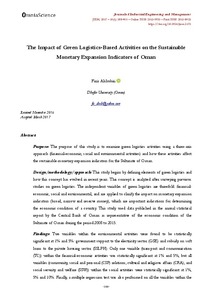Mostra el registre d'ítem simple
The Impact of Green Logistics-Based Activities on the Sustainable Monetary Expansion Indicators of Oman
| dc.contributor.author | Alshubiri, Faris |
| dc.coverage.spatial | east=58.414306640625; north=23.553916518321625; name=Muscat, Oman |
| dc.date.accessioned | 2017-05-25T17:16:36Z |
| dc.date.available | 2017-05-25T17:16:36Z |
| dc.date.issued | 2017-05 |
| dc.identifier.citation | Alshubiri, F. The Impact of Green Logistics-Based Activities on the Sustainable Monetary Expansion Indicators of Oman. "Journal of Industrial Engineering and Management", Maig 2017, vol. 10, núm. 2, p. 388-405. |
| dc.identifier.issn | 2013-0953 |
| dc.identifier.uri | http://hdl.handle.net/2117/104875 |
| dc.description.abstract | Purpose: The purpose of this study is to examine green logistics activities using a three-axis approach (financial-economic, social and environmental activities) and how these activities affect the sustainable monetary expansion indicators for the Sultanate of Oman. Design/methodology/approach: This study begins by defining elements of green logistics and how this concept has evolved in recent years. This concept is analyzed after surveying previous studies on green logistics. The independent variables of green logistics are threefold: financialeconomic, social and environmental, and are applied to clarify the impact on monetary expansion indicators (broad, narrow and reserve money), which are important indications for determining the economic condition of a country. This study used data published in the annual statistical report by the Central Bank of Oman as representative of the economic condition of the Sultanate of Oman during the period 2008 to 2015. Findings: Two variables within the environmental activities were found to be statistically significant at 1% and 5%: government support to the electricity sector (GSE) and subsidy on soft loans to the private housing sector (SSLPH). Only one variable (transport and communication (TC)) within the financial-economic activities was statistically significant at 1% and 5%, but all variables (community, social and personal (CSP) relations; cultural and religious affairs (CRA); and social security and welfare (SSW)) within the social activities were statistically significant at 1%, 5% and 10%. Finally, a multiple regression test was also performed on all the variables within the green logistics activities and all the monetary expansion indicators, and they were found to be statistically significant at 1% and 5%. The study recommends that attention should be given to financial-economic activities as a quantitative standard that contributes to developing green logistics. This would entail a diagnosis of the priorities and the existing economic and financial system that contributes to sustainable development of the country's economy. It would also be important to activate the industrial sectors by reducing operating costs and improving the quality of service provided to customers, an indicator of the social activities that conform green logistics, and to increase corporate awareness of the environmental variables and the behavior of consumers in order to establish a financial-economic system based on the concept of green logistics. Research limitations: The available data in the annual statistical report for Oman is limited, which limits the period and all the variables of the study. Practical implications: The management of companies should be adopting green logistics operations if they compare the results of the concepts considered in this study with those of their competitors in the market, in order to consolidate their position in the market. Furthermore, the concept of green logistics helps companies build an intellectual model that contributes to enhancing added value. The results of this study enhance the stability of monetary expansion indicators reflecting economic growth. Social implications: Green logistics plays a behavioral role in the company’s and country’s performance and determines the trends and attitudes for the future growth of companies, especially regarding the environmental indicators. Originality/value: This study aims to analyze green logistics in the financial-economic, social and environmental areas, which reflect the greatest variations, especially as they are affected by changes in global markets, particularly with respect to oil prices, the main source of revenue for the Sultanate of Oman. This is of particular interest as green logistics is one of the modern concepts that are influencing the development of corporate strategies to implement economic plans in the country. This study has also supplied a conceptual research framework to explain green logistics in preparation for many future studies that will examine its elements. |
| dc.format.extent | 18 p. |
| dc.language.iso | eng |
| dc.publisher | OmniaScience |
| dc.rights | Attribution-NonCommercial 3.0 Spain |
| dc.rights.uri | http://creativecommons.org/licenses/by-nc/3.0/es/ |
| dc.subject | Àrees temàtiques de la UPC::Economia i organització d'empreses::Direcció d'operacions |
| dc.subject | Àrees temàtiques de la UPC::Economia i organització d'empreses::Impacte ambiental |
| dc.subject.lcsh | Business logistics--Environmental aspects |
| dc.subject.other | Green logistics activities |
| dc.subject.other | Monetary expansion |
| dc.subject.other | Sustainable development |
| dc.subject.other | Sultanate of Oman |
| dc.title | The Impact of Green Logistics-Based Activities on the Sustainable Monetary Expansion Indicators of Oman |
| dc.type | Article |
| dc.subject.lemac | Logística (Indústria) -- Aspectes ambientals |
| dc.identifier.doi | 10.3926/jiem.2173 |
| dc.identifier.dl | B-28744-2008 |
| dc.description.peerreviewed | Peer Reviewed |
| dc.rights.access | Open Access |
| local.citation.publicationName | Journal of Industrial Engineering and Management |
| local.citation.volume | 10 |
| local.citation.number | 2 |
| local.citation.startingPage | 388 |
| local.citation.endingPage | 405 |
Fitxers d'aquest items
Aquest ítem apareix a les col·leccions següents
-
2017, vol. 10, núm. 2 [11]
Special Issue - Supply chain and logistics decisions under environmental aspect


